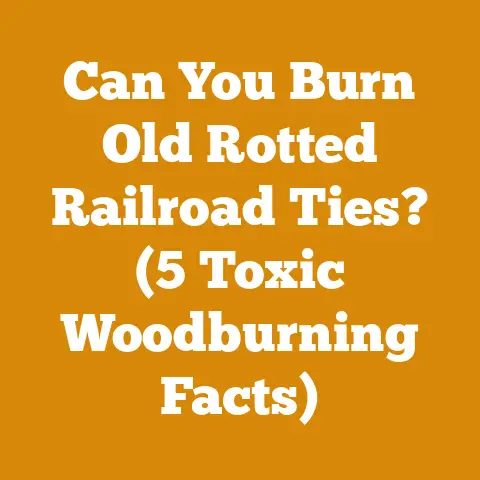Chainsaw Not Starting? (5 Pro Tips to Get It Running Fast)
Ever yanked on a chainsaw starter cord, expecting that familiar roar, only to be met with… silence?
It’s a frustrating experience I know all too well.
Over the years, I’ve spent countless hours in the woods, felling trees and preparing firewood.
And trust me, a chainsaw that refuses to start is more than just an inconvenience; it’s a productivity killer.
But don’t throw in the towel just yet!
A non-starting chainsaw is often a problem with a simple fix.
I’m going to share five pro tips I’ve learned the hard way – through trial, error, and plenty of frustrating moments – to get your chainsaw running fast.
Key Takeaways:
- Fresh Fuel is Crucial: Stale fuel is the number one culprit for starting problems.
I’ll show you how to identify bad fuel and the right way to mix and store it. - Spark Plug Inspection is Key: A fouled or damaged spark plug can prevent ignition.
I’ll walk you through the steps to inspect, clean, and replace your spark plug. - Air Filter Maintenance Matters: A clogged air filter restricts airflow, leading to a rich fuel mixture and a flooded engine.
I’ll explain how to clean and maintain your air filter for optimal performance. - Carburetor Issues Can Be Solved: Carburetor problems can prevent fuel from reaching the engine.
I’ll cover some basic troubleshooting steps and when it’s time to call a professional. - Pull Cord Problems are Fixable: A stuck or broken pull cord can prevent you from starting the chainsaw.
I’ll guide you through the process of inspecting and repairing your pull cord mechanism.
So, grab your tools, and let’s get that chainsaw roaring again!
Chainsaw Not Starting? (5 Pro Tips to Get It Running Fast)
1. The Fuel Factor: Is Your Mix Rotten?
I can’t stress this enough: fresh fuel is the lifeblood of your chainsaw. Stale or improperly mixed fuel is the number one reason why chainsaws refuse to start.
Think of it like this: you wouldn’t expect a car to run on gasoline that’s been sitting in a tank for years, would you?
The same principle applies to your chainsaw.
The Science Behind Stale Fuel
Gasoline degrades over time, especially when mixed with oil for two-stroke engines.
Here’s what happens:
- Evaporation: Lighter hydrocarbons in the gasoline evaporate, reducing its volatility and making it harder to ignite.
- Oxidation: Gasoline reacts with oxygen, forming gum and varnish deposits that can clog fuel lines, jets, and carburetor components.
- Oil Separation: In two-stroke mixtures, the oil can separate from the gasoline, leading to improper lubrication and engine damage.
Data Point: According to a study by the American Society for Testing and Materials (ASTM), gasoline can begin to degrade in as little as 30 days, especially when exposed to air and temperature fluctuations.
My Fuel Story: A Costly Lesson
I once made the mistake of using a fuel mix that had been sitting in my garage for almost a year.
I thought, “It’s just a little old, it’ll probably be fine.” Boy, was I wrong!
The chainsaw sputtered, coughed, and refused to start, no matter how hard I pulled.
After multiple attempts, I ended up flooding the engine and wasting precious time.
I eventually had to drain the tank, clean the carburetor, and mix a fresh batch of fuel.
The lesson?
Don’t underestimate the power of fresh fuel.
How to Identify Bad Fuel
Here are a few telltale signs that your fuel has gone bad:
- Smell: Fresh gasoline has a distinct, pungent odor.
Stale fuel often smells sour, varnish-like, or simply “off.” - Color: Fresh gasoline is usually clear or slightly tinted.
Stale fuel may appear darker, cloudy, or contain visible sediments. - Performance: If your chainsaw starts but runs poorly, sputters, or lacks power, stale fuel is a likely culprit.
The Right Way to Mix and Store Fuel
To ensure your fuel stays fresh and your chainsaw runs smoothly, follow these guidelines:
- Use Fresh Gasoline: Purchase gasoline from a reputable source and use it within 30 days.
- Use the Correct Oil: Use a high-quality two-stroke oil specifically designed for air-cooled engines.
Follow the manufacturer’s recommended mixing ratio (usually 50:1 or 40:1). - Mix Thoroughly: Use a dedicated fuel mixing container with accurate measurement markings.
Pour the oil into the container first, then add the gasoline.
Shake vigorously for at least 30 seconds to ensure proper mixing. - Store Properly: Store fuel in a clean, airtight container in a cool, dark, and dry place.
Avoid storing fuel in direct sunlight or near heat sources. - Stabilize Fuel: If you plan to store fuel for more than 30 days, add a fuel stabilizer to prevent degradation.
Follow the manufacturer’s instructions for dosage. - Label and Date: Label the fuel container with the date of mixing and the oil-to-gasoline ratio.
“They prevent the formation of gum and varnish deposits, keeping your engine running smoothly.”Draining and Replacing Fuel: A Step-by-Step Guide
If you suspect your fuel is bad, here’s how to drain and replace it:
- Locate the Fuel Tank: Find the fuel tank on your chainsaw.
It’s usually a translucent or colored plastic container with a fuel cap. - Prepare a Container: Place a suitable container beneath the fuel tank to catch the drained fuel.
- Remove the Fuel Cap: Carefully remove the fuel cap and set it aside.
- Drain the Fuel: Depending on your chainsaw model, you may need to disconnect the fuel line from the carburetor or use a siphon to drain the fuel.
- Dispose of Fuel Properly: Dispose of the old fuel responsibly at a designated hazardous waste collection site.
Do not pour it down the drain or onto the ground. - Refill with Fresh Fuel: Mix a fresh batch of fuel using the correct oil-to-gasoline ratio and pour it into the fuel tank.
- Prime the Carburetor: Prime the carburetor by pressing the primer bulb (if equipped) several times until fuel is visible.
- Start the Chainsaw: Follow the starting procedure outlined in your chainsaw’s owner’s manual.
Call to Action: Don’t let stale fuel ruin your day!
Invest in a fuel stabilizer and follow proper mixing and storage procedures.
Your chainsaw (and your back) will thank you.2.
Spark Plug Inspection: The Heart of IgnitionThe spark plug is the unsung hero of your chainsaw’s engine.
It delivers the electrical spark that ignites the fuel-air mixture, creating the combustion that powers the saw.
A faulty spark plug can lead to a no-start condition, rough running, or reduced power.Understanding the Spark Plug
A spark plug consists of several key components:
- Electrode: The central electrode carries the high-voltage current from the ignition system.
- Ground Electrode: The ground electrode is attached to the spark plug body and forms a gap with the center electrode.
- Insulator: The insulator prevents the high-voltage current from short-circuiting to the spark plug body.
- Terminal: The terminal connects the spark plug to the ignition wire.
Data Point: The spark plug gap – the distance between the center and ground electrodes – is crucial for proper ignition.
A gap that is too wide or too narrow can result in a weak spark or no spark at all.My Spark Plug Mishap: A Smoky Situation
I remember one time when I was cutting firewood on a particularly cold day.
My chainsaw started fine initially, but after a few minutes, it began to run rough and emit excessive smoke.
I suspected a carburetor issue, but after some troubleshooting, I discovered that the spark plug was heavily fouled with carbon deposits.
The spark plug wasn’t able to ignite the fuel-air mixture efficiently, leading to incomplete combustion and the smoky exhaust.
A quick spark plug replacement solved the problem instantly.Common Spark Plug Problems
Here are some common spark plug problems that can prevent your chainsaw from starting:
- Fouling: Carbon deposits, oil, or fuel can accumulate on the spark plug electrodes, preventing a spark from jumping across the gap.
- Cracking: The insulator can crack due to thermal stress or physical damage, causing the high-voltage current to leak to the spark plug body.
- Corrosion: The electrodes can corrode over time, reducing their ability to conduct electricity.
- Incorrect Gap: The spark plug gap may be too wide or too narrow, resulting in a weak spark or no spark at all.
How to Inspect Your Spark Plug
Follow these steps to inspect your spark plug:
- Locate the Spark Plug: Find the spark plug on your chainsaw.
It’s usually located on the side of the engine, near the cylinder head. - Disconnect the Spark Plug Wire: Carefully disconnect the spark plug wire from the spark plug terminal.
- Remove the Spark Plug: Use a spark plug wrench to unscrew the spark plug from the cylinder head.
- Inspect the Electrodes: Examine the electrodes for signs of fouling, corrosion, or damage.
The electrodes should be clean and dry, with a sharp edge. - Inspect the Insulator: Check the insulator for cracks or chips.
- Check the Gap: Use a spark plug gap tool to measure the gap between the electrodes.
Compare the measurement to the specification in your chainsaw’s owner’s manual. - Clean or Replace the Spark Plug: If the spark plug is fouled, clean it with a wire brush or spark plug cleaner.
If the spark plug is damaged or corroded, replace it with a new one. - Reinstall the Spark Plug: Screw the spark plug back into the cylinder head, tightening it to the specified torque.
- Reconnect the Spark Plug Wire: Reconnect the spark plug wire to the spark plug terminal.
Expert Insight: “A healthy spark plug should have a light tan or gray color,” says John Deere, a leading manufacturer of outdoor power equipment.
“Black, oily, or wet spark plugs indicate a problem with the engine.”Cleaning a Fouled Spark Plug
If your spark plug is fouled with carbon deposits, you can try cleaning it using these methods:
- Wire Brush: Use a wire brush to gently scrub the electrodes and remove any loose deposits.
- Spark Plug Cleaner: Use a commercially available spark plug cleaner to dissolve stubborn deposits.
Follow the manufacturer’s instructions. - Sandblasting: For heavily fouled spark plugs, you can use a sandblaster to remove the deposits.
Be careful not to damage the electrodes.
Caution: Avoid using harsh chemicals or abrasive materials to clean your spark plug, as they can damage the electrodes or insulator.
Setting the Spark Plug Gap
The spark plug gap is critical for proper ignition.
Use a spark plug gap tool to measure and adjust the gap to the specification in your chainsaw’s owner’s manual.- Insert the Gap Tool: Insert the gap tool between the electrodes.
- Adjust the Gap: If the gap is too wide, gently tap the ground electrode against a hard surface to close the gap.
If the gap is too narrow, use the gap tool to pry the ground electrode open. - Recheck the Gap: Recheck the gap with the gap tool to ensure it is within the specified range.
Data Point: A spark plug gap that is too wide can result in a weak spark, while a gap that is too narrow can cause the spark to jump prematurely.
Replacing the Spark Plug
If your spark plug is damaged, corroded, or heavily fouled, it’s best to replace it with a new one.
- Purchase a New Spark Plug: Buy a new spark plug that is compatible with your chainsaw model.
Consult your owner’s manual for the correct spark plug type and part number. - Install the New Spark Plug: Screw the new spark plug into the cylinder head, tightening it to the specified torque.
- Reconnect the Spark Plug Wire: Reconnect the spark plug wire to the spark plug terminal.
Call to Action: Don’t neglect your spark plug!
Inspect it regularly, clean it when necessary, and replace it when it’s worn out.
A healthy spark plug is essential for reliable chainsaw performance.3.
Air Filter Maintenance: Breathing Easy for PowerThe air filter is your chainsaw’s first line of defense against dirt, dust, and debris.
A clean air filter ensures that the engine receives a sufficient supply of clean air for proper combustion.
A clogged air filter restricts airflow, leading to a rich fuel mixture, reduced power, and a no-start condition.The Importance of Clean Air
Chainsaw engines require a precise mixture of air and fuel for optimal performance.
When the air filter is clogged, the engine receives less air than it needs, resulting in a rich fuel mixture (too much fuel, not enough air).
This can lead to:- Reduced Power: The engine won’t be able to generate as much power, making it difficult to cut through tough wood.
- Rough Running: The engine may run rough, sputter, or stall.
- Increased Fuel Consumption: The engine will burn more fuel than necessary, wasting money and increasing emissions.
- Engine Damage: Over time, a rich fuel mixture can lead to carbon buildup in the engine, causing damage to the pistons, cylinders, and valves.
Data Point: A study by the Engine Manufacturers Association (EMA) found that a clogged air filter can reduce engine power by as much as 20%.
My Air Filter Fiasco: A Costly Mistake
I once ignored my air filter for far too long.
I was in the middle of a big firewood cutting project and didn’t want to take the time to clean it.
The chainsaw started to lose power, but I kept pushing it, thinking it was just the wood being extra tough.
Eventually, the engine started smoking and running really rough.
I finally checked the air filter, and it was completely clogged with sawdust and debris.
I had to take the chainsaw to a repair shop, and the mechanic told me that the rich fuel mixture had caused significant carbon buildup in the engine.
The repair cost me a pretty penny and a lot of downtime.
I learned my lesson: air filter maintenance is not something to be taken lightly.Types of Air Filters
Chainsaws typically use one of two types of air filters:
- Foam Filters: Foam filters are made of porous foam material that traps dirt and debris.
They are washable and reusable. - Paper Filters: Paper filters are made of pleated paper material that provides excellent filtration.
They are not washable and must be replaced when they become clogged.
How to Inspect Your Air Filter
Follow these steps to inspect your air filter:
- Locate the Air Filter: Find the air filter housing on your chainsaw.
It’s usually located on the side or top of the engine, near the carburetor. - Remove the Air Filter Cover: Remove the air filter cover by unscrewing the retaining screws or clips.
- Remove the Air Filter: Carefully remove the air filter from the housing.
- Inspect the Air Filter: Examine the air filter for signs of dirt, dust, and debris.
Hold the air filter up to a light source to see if light can pass through.
If the air filter is heavily soiled or clogged, it needs to be cleaned or replaced.
Cleaning a Foam Air Filter
To clean a foam air filter, follow these steps:
- Remove Loose Debris: Gently tap the air filter against a hard surface to remove any loose debris.
- Wash the Air Filter: Wash the air filter in warm, soapy water.
Use a mild detergent and avoid harsh chemicals. - Rinse Thoroughly: Rinse the air filter thoroughly with clean water until all traces of soap are gone.
- Dry the Air Filter: Allow the air filter to air dry completely before reinstalling it.
Do not use a heat source to dry the air filter, as this can damage the foam material. - Oil the Air Filter (Optional): Some foam air filters require oiling to improve their filtration efficiency.
Consult your chainsaw’s owner’s manual for specific instructions.
Replacing a Paper Air Filter
Paper air filters cannot be cleaned and must be replaced when they become clogged.
- Purchase a New Air Filter: Buy a new air filter that is compatible with your chainsaw model.
Consult your owner’s manual for the correct air filter type and part number. - Install the New Air Filter: Carefully install the new air filter into the air filter housing.
- Reinstall the Air Filter Cover: Reinstall the air filter cover and tighten the retaining screws or clips.
Expert Insight: “Clean your air filter every 25 hours of use, or more often if you are working in dusty conditions,” says Stihl, a leading manufacturer of chainsaws and other outdoor power equipment.
Air Filter Maintenance Schedule
Here’s a general guideline for air filter maintenance:
- Inspect: Inspect the air filter before each use.
- Clean (Foam Filters): Clean the air filter every 25 hours of use, or more often if you are working in dusty conditions.
- Replace (Paper Filters): Replace the air filter every 50 hours of use, or more often if it becomes heavily clogged.
Call to Action: Keep your chainsaw breathing easy!
Inspect and clean or replace your air filter regularly to ensure optimal performance and prevent engine damage.4.
Carburetor Conundrums: Fuel Delivery ProblemsThe carburetor is responsible for mixing air and fuel in the correct proportions to create a combustible mixture.
A malfunctioning carburetor can prevent fuel from reaching the engine, leading to a no-start condition.How the Carburetor Works
The carburetor works by using a venturi to create a low-pressure area that draws fuel into the air stream.
The carburetor also has several adjustable screws that control the fuel-air mixture:- Idle Speed Screw: Controls the engine’s idle speed.
- Low-Speed Screw: Controls the fuel-air mixture at low engine speeds.
- High-Speed Screw: Controls the fuel-air mixture at high engine speeds.
Data Point: The ideal air-fuel ratio for a chainsaw engine is typically around 14.7:1 (14.7 parts air to 1 part fuel).
Common Carburetor Problems
Here are some common carburetor problems that can prevent your chainsaw from starting:
- Clogged Jets: The carburetor jets are small openings that allow fuel to flow into the air stream.
These jets can become clogged with dirt, varnish, or fuel deposits. - Sticking Needle Valve: The needle valve controls the flow of fuel into the carburetor bowl.
If the needle valve sticks, it can prevent fuel from entering the carburetor. - Leaking Carburetor Gasket: The carburetor gasket seals the carburetor to the engine.
If the gasket is damaged or leaking, it can cause air leaks that disrupt the fuel-air mixture. - Incorrect Carburetor Adjustment: If the carburetor screws are not adjusted correctly, the fuel-air mixture may be too rich or too lean, preventing the engine from starting.
My Carburetor Catastrophe: A Frustrating Experience
I once spent an entire afternoon trying to start a chainsaw that had been sitting unused for several months.
I checked the fuel, the spark plug, and the air filter, but everything seemed to be in order.
I finally decided to take a look at the carburetor, and I discovered that the jets were completely clogged with varnish deposits from the old fuel.
I tried cleaning the jets with carburetor cleaner, but it didn’t work.
I ended up having to disassemble the entire carburetor and soak the parts in a carburetor cleaning solution overnight.
After reassembling the carburetor, the chainsaw started right up.
It was a long and frustrating process, but I learned a valuable lesson about the importance of carburetor maintenance.Basic Carburetor Troubleshooting
Here are some basic troubleshooting steps you can take to diagnose carburetor problems:
- Check the Fuel Line: Make sure the fuel line is connected to the carburetor and that there are no kinks or leaks.
- Check the Fuel Filter: The fuel filter is located inside the fuel tank and prevents dirt and debris from entering the carburetor.
If the fuel filter is clogged, it can restrict fuel flow. - Prime the Carburetor: Prime the carburetor by pressing the primer bulb (if equipped) several times until fuel is visible.
- Adjust the Idle Speed Screw: Turn the idle speed screw clockwise to increase the engine’s idle speed.
- Adjust the Low-Speed Screw: Turn the low-speed screw clockwise to lean out the fuel-air mixture at low engine speeds.
- Adjust the High-Speed Screw: Turn the high-speed screw clockwise to lean out the fuel-air mixture at high engine speeds.
Caution: Be careful not to overtighten the carburetor screws, as this can damage the carburetor.
Cleaning the Carburetor
If you suspect that your carburetor is clogged, you can try cleaning it using these methods:
- Carburetor Cleaner: Spray carburetor cleaner into the carburetor jets and passages to dissolve dirt and varnish deposits.
- Compressed Air: Use compressed air to blow out the carburetor jets and passages.
- Carburetor Cleaning Solution: Disassemble the carburetor and soak the parts in a carburetor cleaning solution overnight.
Expert Insight: “Carburetor cleaning is best left to a qualified technician,” says Briggs & Stratton, a leading manufacturer of small engines.
“Improper cleaning can damage the carburetor and lead to further problems.”When to Call a Professional
If you’ve tried the basic troubleshooting steps and cleaning methods and your chainsaw still won’t start, it’s time to call a professional.
Carburetor repair can be complex and requires specialized tools and knowledge.
A qualified technician can diagnose the problem and repair or replace the carburetor as needed.Call to Action: Don’t let carburetor problems keep you from cutting wood!
Perform regular maintenance and troubleshooting, and don’t hesitate to call a professional when needed.5.
Pull Cord Problems: When the Starter Won’t CooperateThe pull cord is the mechanism you use to start your chainsaw.
A stuck or broken pull cord can prevent you from starting the chainsaw, even if everything else is in perfect working order.How the Pull Cord Works
The pull cord is connected to a recoil spring and a pulley.
When you pull the cord, the pulley turns the engine’s crankshaft, which starts the engine.
The recoil spring then retracts the cord back into the housing.Common Pull Cord Problems
Here are some common pull cord problems that can prevent your chainsaw from starting:
- Stuck Pull Cord: The pull cord may be stuck due to dirt, debris, or a broken recoil spring.
- Broken Pull Cord: The pull cord may break due to wear and tear or excessive force.
- Broken Recoil Spring: The recoil spring may break, preventing the cord from retracting.
- Damaged Pulley: The pulley may be damaged, preventing the cord from turning the engine’s crankshaft.
My Pull Cord Predicament: A Tugging Tale
I was once deep in the woods, cutting firewood, when my chainsaw’s pull cord suddenly snapped.
I was miles from my truck and had no spare cord with me.
I tried to tie the broken ends together, but the knot kept slipping.
I was starting to panic, thinking I would have to hike out of the woods without my chainsaw.
Luckily, I remembered that I had some strong paracord in my backpack.
I carefully removed the broken cord from the pulley and replaced it with the paracord.
It wasn’t a perfect solution, but it allowed me to finish my work and get back to my truck.
I learned a valuable lesson that day: always carry a spare pull cord with you when working in the woods.How to Inspect Your Pull Cord
Follow these steps to inspect your pull cord:
- Locate the Pull Cord Housing: Find the pull cord housing on your chainsaw.
It’s usually located on the side of the engine. - Pull the Cord: Gently pull the cord out of the housing.
- Inspect the Cord: Examine the cord for signs of wear and tear, such as fraying, cuts, or breaks.
- Inspect the Recoil Spring: Check to see if the recoil spring is retracting the cord properly.
If the cord is not retracting, the recoil spring may be broken. - Inspect the Pulley: Check the pulley for damage, such as cracks or chips.
Repairing a Stuck Pull Cord
If your pull cord is stuck, try these steps:
- Clean the Housing: Remove the pull cord housing and clean it thoroughly with a brush and compressed air.
- Lubricate the Cord: Lubricate the cord with a silicone-based lubricant.
- Free the Recoil Spring: If the recoil spring is stuck, try gently twisting the pulley to free it.
Replacing a Broken Pull Cord
If your pull cord is broken, you’ll need to replace it with a new one.
- Purchase a New Pull Cord: Buy a new pull cord that is compatible with your chainsaw model.
Consult your owner’s manual for the correct cord diameter and length. - Remove the Old Cord: Remove the pull cord housing and carefully remove the broken cord from the pulley.
- Install the New Cord: Thread the new cord through the pulley and tie a knot at the end to secure it.
- Rewind the Recoil Spring: Rewind the recoil spring by turning the pulley in the opposite direction of the cord’s travel.
- Reinstall the Pull Cord Housing: Reinstall the pull cord housing and test the cord to make sure it retracts properly.
Expert Insight: “When replacing a pull cord, always use a high-quality cord that is designed for outdoor power equipment,” says Husqvarna, a leading manufacturer of chainsaws and other forestry equipment.
Replacing a Broken Recoil Spring
Replacing a broken recoil spring can be tricky and requires some mechanical skill.
If you’re not comfortable doing it yourself, it’s best to take your chainsaw to a qualified repair technician.Call to Action: Don’t let a broken pull cord keep you from working!
Inspect your pull cord regularly, and replace it when it’s worn out or broken.Conclusion: Back to the Woods
Troubleshooting a chainsaw that won’t start can seem daunting, but by systematically addressing these five key areas – fuel, spark plug, air filter, carburetor, and pull cord – you can often get your saw running quickly and efficiently.
Remember, prevention is always better than cure.
Regular maintenance, proper fuel storage, and careful handling will go a long way in keeping your chainsaw in top condition.I hope these tips have been helpful.
Now, get back out there and make some sawdust! - Locate the Fuel Tank: Find the fuel tank on your chainsaw.






